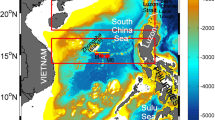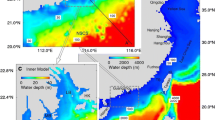Abstract
A three-dimensional baroclinic shelf sea model's numerical simulation of the South China Sea (SCS) middle and deep layer circulation structure showed that: 1. In the SCS middle and deep layer, a southward boundary current exists along the east shore of the Indo-China Peninsula all year long. A cyclonic eddy (gyre) is formed by the current in the above sea areas except in the middle layer in spring, when an anticyclonic eddy exists on the eastern side of the current. In the deep layer, a large-scale anticyclonic eddy often exists in the sea areas between the Zhongsha Islands and west shore of southern Luzon Island. 2. In the middle layer in summer and autumn, and in the deep layer in autumn and winter, there is an anticyclonic eddy (gyre) in the northeastern SCS, while in the middle layer in winter and spring, and in the deep layer in spring and summer, there is a cyclonic one. 3. In the middle layer, there is a weak northeastward current in the Nansha Trough in spring and summer, while in autumn and winter it evolves into an anticyclonic eddy (gyre), which then spreads westward to the whole western Nansha Islands sea areas.
Similar content being viewed by others
References
Cai, S., Gan, Z., Su, J. et al., 2001. Three-dimensional baroclinic numerical simulation of the South China Sea circulation's seasonal characteristics I. upper circulation.Chin. J. Oceanol. Limnol. 19(3): 208–216.
Chao, S. Y., Shaw, P. T., Wu, S. Y., 1996. Deep water ventilation in the South China Sea.Deep-Sea Research 43(4): 445–466.
Fang, W., Guo, Z., Huang, Y., 1997. Observation study of circulation in the southern sea areas of the South China Sea.Chinese Science Bulletin 42(21): 2264–2271. (in Chinese)
Shaw, P. T., Chao, S. Y., 1994. Surface circulation in the South China Sea.Deep-Sea Research 41 (11–12): 1663–1683.
Xu, J., Su, J., 1997. Hydrographic analysis on the intruding of Kuroshio water into the South China Sea II. The observational results during Aug.–Sept., 1994.Tropical Ocean 16(2): 1–23. (in Chinese)
Xu, X., Qiu, Z., Chen, H., 1980. Summary of horizontal circulation in the South China Sea.In: Symposium Proceedings of Hydrology and Meteorology Society of China, Science Press, Beijing, p. 137–145. (in Chinese)
Wang, Z., 1990. The investigation of the cold gyre in the bottom layer of the northern South China Sea.Study and development in the South China Sea 5: 15–20.
Author information
Authors and Affiliations
Additional information
Project 49636230 supported by NSFC and Grant KZ951-B1-408 from Chinese Academy of Sciences, and was also supported by the Major State Basic Research Program (No. G1999043806).
Rights and permissions
About this article
Cite this article
Shu-qun, C., Zi-jun, G., Ji-lan, S. et al. Three-dimensional baroclinic numerical simulation of the South China sea circulation's seasonal characteristics II. Middle and deep circulation. Chin. J. Ocean. Limnol. 20, 9–15 (2002). https://doi.org/10.1007/BF02846606
Received:
Accepted:
Issue Date:
DOI: https://doi.org/10.1007/BF02846606




